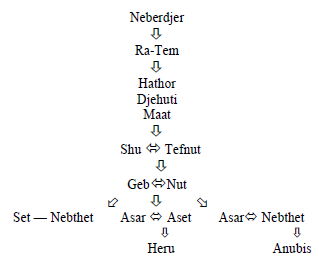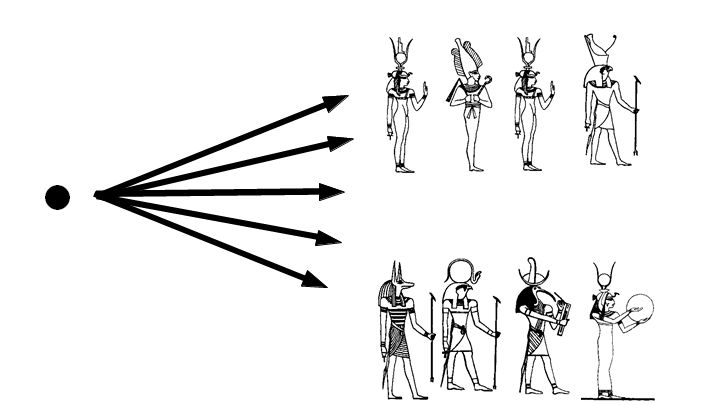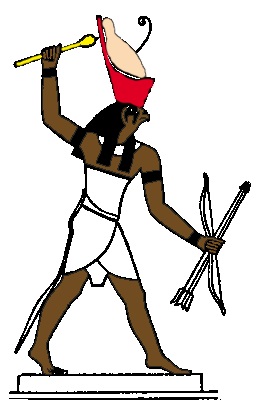FROM THE BOOK
MYSTERIES OF ISIS
by
Sebai Muata Ashby
A Compendium of the Ausarian Resurrection Myth
The Asarian Resurrection myth of Ancient Egypt is an important source for the knowledge and wisdom of Goddess Aset. It provides the essential knowledge of the origins and mission of Aset as well as the mystic insight into the purpose of life and the work of her temple. What follows below is a summary of the Asarian Resurrection myth and an introduction to its teachings. This is part of the initiatic study curriculum of the Temple of Aset and is presented here only as an introduction to the wisdom of the myth but a full initiatic study requires years and ultimately accepting the teaching of the goddess, being instructed by her priests and priestesses and living its practices in day to day life.
THE CREATION
The process of creation is explained in the form of a cosmological system for better understanding. Cosmology is a branch of philosophy dealing with the origin, processes, and structure of the universe. Cosmogony is the astrophysical study of the creation and evolution of the universe. Both of these disciplines are inherent facets of Egyptian philosophy through the main religious systems or Companies of the Gods and Goddesses. A company of gods and goddesses is a group of deities which symbolize a particular cosmic force or principle which emanates from the all-encompassing Supreme Being, from which they have emerged. The Self or Supreme Being manifests creation through the properties and principles represented by the Pautti Company of gods and goddesses-cosmic laws of nature. The system or company of gods and goddesses of Anu is regarded as the oldest, and forms the basis of the Osirian Trinity. It is expressed in the diagram below.
The diagram above shows that Psedjet (Ennead), or the creative principles which are embodied in the primordial gods and goddesses of creation, emanated from the Supreme Being. Ra or Ra-Tem arose out of the “Nu”, the Primeval waters, the hidden essence, and began sailing the “Boat of Millions of Years” which included the company of gods and goddesses. On his boat emerged the “Neters” or cosmic principles of creation. The Neters of the Ennead are Ra-Atum, Shu, Tefnut, Geb, Nut, Asar, Aset, Set, and Nebthet. Hathor, Djehuti and Maat represent attributes of the Supreme Being as the very stuff or substratum which makes up creation. Shu, Tefnut, Geb, Nut, Asar, Aset, Set, and Nebthet represent the principles upon which creation manifests. Anubis is not part of the Ennead. He represents the feature of intellectual discrimination in the Osirian myth. “Sailing” signifies the beginning of motion in creation. Motion implies that events occur in the realm of time and space, thus, the phenomenal universe comes into existence as a mass of moving essence we call the elements. Prior to this motion, there was the primeval state of being without any form and without existence in time or space.
Above: The Supreme Being, Nebertcher, manifests as the various gods and goddesses as well as human beings, nature and the elements. Thus, from The One arise many, however, all objects are in reality a reflection of The one. Since a reflection is not real, only The One is real. Therefore, even though there appears to be multiplicity and duality in creation, these are only illusions based on human ignorance. All is one and the one is God.
Asar, Aset and Heru
Asar and Aset dedicated themselves to the welfare of humanity and sought to spread civilization throughout the earth, even as far as India and China.
During the absence of Asar from his kingdom, his brother Set had no opportunity to make innovations in the state, because Aset was extremely vigilant in governing the country, and always upon her guard and watchful for any irregularity or unrighteousness.
Upon Asar’ return from touring the world and carrying the teachings of wisdom abroad, there was merriment and rejoicing throughout the land. However, one day after Asar’ return, through his lack of vigilance, became intoxicated and slept with Set’s wife, Nebthet. Nebthet, as a result of the union with Asar, begot Anubis.
Set, who represents the personification of evil forces, plotted in jealousy and anger (the blinding passion that prevents forgiveness and understanding) to usurp the throne and
conspired to kill Asar. Set secretly got the measurements of Asar and constructed a coffin. Through trickery, Set was able to get Asar to “try on” the coffin for size. While Asar was resting in the coffin, Set and his assistants locked it and then dumped it into the Nile river.
The coffin made its way to the coast of Syria where it became embedded in the earth and from it grew a tree with the most pleasant aroma in the form of a DJED . The DJED is the symbol of Asar’ BACK. It has four horizontal lines in relation to a firmly established, straight column. The DJED column is symbolic of the upper energy centers (chakras) that relate to the levels of consciousness of the spirit.
The King of Syria was out walking and as he passed by the tree, he immediately fell in love with the pleasant aroma, so he had the tree cut down and brought to his palace. Aset (Auset, Ast), Asar’ wife, who is the personification of the life giving, mother force in creation and in all humans, went to Syria in search of Asar. Her search led her to the palace of the Syrian King where she took a job as the nurse of the King’s son. Every evening, Aset would put the boy into the “fire” to consume his mortal parts, thereby transforming him to immortality. Fire is symbolic of both physical and mental purification. Most importantly, fire implies wisdom, the light of truth, illumination and energy which burns away ignorance and egoism. Aset, by virtue of her qualities, has the power to bestow immortality through the trans-formative power of her symbolic essence. So intuitional wisdom leads to the eradication of mortal consciousness and the birth of immortal contentiousness when one’s intuition allows one to realize one’s true nature. Aset then told the king that Asar, her husband, is inside the pillar he made from the tree. He graciously gave her the pillar (DJED) and she returned with it to Kamit (Kmt, Egypt). With the assistance of Sebek Aset brought back the body of Asar.
Isis and Nephthys bewailing over the dead body of Osiris as they would later do over the dead body of Horus. From a bas relief at the temple of Isis in Philae.
Upon her return to Kmt, Aset went to the papyrus swamps where she lay over Asar’ dead body and fanned him with her wings, infusing him with new life. In this manner Aset revived
Asar through her power of love and wisdom, and then they united once more. From their union was conceived a son, Heru (Heru), with the assistance of the Gods Djehuti and Amon. Heru, therefore, was born from the union of the spirit of Asar and the life giving power of Aset (physical nature). Thus, Heru represents the union of spirit and matter, and the renewed life of Asar, his rebirth.
One evening, as Set was hunting in the papyrus swamps, he came upon Aset and Asar. In a rage of passion, he dismembered the body of Asar into several pieces and scattered the pieces throughout the land. In this way, it is Set, the brute force of our bodily impulses and desires that “dismembers” our higher intellect. Instead of oneness and unity, we see multiplicity and separateness which give rise to egoistic (selfish) and violent behavior. The Great Mother, Aset, once again set out to search, now for the pieces of Asar, with the help of Anubis and Nebthet.
After searching all over the world, they found all the pieces of Asar’ body, except for his phallus which was eaten by a fish. In Eastern Hindu-Tantra mythology, the God Shiva, who is the equivalent of Asar, also lost his phallus in one story. In Egyptian and Hindu-Tantra mythology, this loss represents seminal retention and celibacy in order to channel the sexual energy to the higher spiritual centers, thereby transforming it into spiritual energy. Aset, through her love, devotion and wisdom and with the help of Apuat, and Nebthet re- membered the pieces, all except the phallus which was eaten by a fish. Asar thus regained life and became the king of the realm of the dead.
Aset took Heru into hiding so that he could grow up safely away from Set. One day Set sent an evil scorpion to find Heru and kill him so that he could not grow up to challenge him for the throne of Egypt. The scorpion found him, stung him and killed Heru. When Aset found out about this she was so grief stricken that her cry was heard to the farthest reaches of the universe. When Ra, the Supreme Being, heard it he stopped his movement. This effectively brought the entire universe to a standstill. In response to Aset Ra sent Djehuti (Greek Hermes) to assist Aset. Djehuti carried special words of power which allowed him to revive Heru.
The birth of Heru (Horus). Aset (Isis) assisted by Djehuty and Amun.
When Heru became a young man, Asar returned from the realm of the dead and encouraged him to take up arms (vitality, wisdom, courage, strength of will) and establish truth, justice and righteousness in the world by challenging Set, its current ruler.
The Battle of Heru (Heru) and Set
The battle between Heru and Set took many twists, sometimes one seeming to get the upper hand and sometimes the other, yet neither one gaining a clear advantage in order to decisively win. At one point, Aset tried to help Heru by catching Set, but due to the pity and compassion she felt towards him, she set him free. In a passionate rage, Heru cut off her head and went off by himself in a frustrated state. Even Heru is susceptible to passion which leads to performing deeds that one later regrets. Set found Heru and gouged out Heru’ eyes. During this time, Heru was overpowered by the evil of Set. He became blinded to truth (as signified by the loss of his eyes) and thus, was unable to do battle (act with MAAT) with Set
. His power of sight was later restored by Hathor (Goddess of passionate love, desire and fierce power), who also represents the left Eye of Ra. She is the fire spitting, destructive power of light, which dispels the darkness (blindness) of ignorance.
When the conflict resumed, the two contendants went before the court of the Ennead Gods (company of the nine Gods who ruled over creation, headed by Ra). Set, promising to end the fight and restore Heru to the throne, invited Heru to spend the night at his house, but Heru soon found out that Set had evil intentions when he tried to have intercourse with him. The uncontrolled Set also symbolizes unrestricted sexual activity. Therefore, all sexual desires should be pursued in accordance with moral and intellectual principles which dictate rules of propriety that lead to health, and personal, societal and spiritual order (MAAT). Juxtaposed against this aspect of Set (uncontrolled sexual potency and desire) is Heru in the form of ithyphallic (erect phallus) MIN, who represents not only control of sexual desire, but its sublimation as well (see Min and Hathor). Min symbolizes the power which comes from the sublimation of the sexual energy.
Through more treachery and deceit, Set attempted to destroy Heru with the help of the Ennead, by tricking them into believing that Heru was not worthy of the throne. Asar sent a letter pleading with the Ennead to do what is correct. Heru, as the son of Asar, should be the rightful heir to the throne. All but two of them (the Ennead) agreed because Heru, they said, was too young to rule. Asar then sent them a second letter (scroll of papyrus with a message) reminding them that even they cannot escape judgment for their deeds; they will be judged in the end when they have to finally go to the West (abode of the dead).
This signifies that even the Gods cannot escape judgment for their deeds. Since all that exists is only a manifestation of the absolute reality which goes beyond time and space, that which is in the realm of time and space (humans, spirits, Gods, Angels, Neters) are all bound by its laws.
Following the receipt of Asar’ scroll (letter), Heru was crowned King of Egypt. Set accepted the decision and made peace with Heru. All the Gods rejoiced. Thus ends the legend of Asar, Aset, and Heru. The Resurrection of Asar and his reincarnation in the form of Heru is a symbol for the resurrection which must occur in the life of every human being. In this manner, the story of the Osirian Trinity, Asar, Aset and Heru, and the Egyptian Ennead
holds hidden teachings, which when understood and properly practiced, will lead to spiritual enlightenment.
So Aset is the true heroine of the entire myth relating to Asar. It was because of Aset’s love, devotion and knowledge of how to call on the Divine (Ra) that Heru, the redeemer of righteousness upon earth, was resurrected.
So what was this special nature of the goddess which allowed her to resurrect Asar and Heru and what is the significance of this resurrection? What relation does it have to people in modern times?
THE DEEPER MEANING OF THE MYTHS OF THE GODDESS ASET
The Deeper mystic meaning of the myth is Explored in the Introduction to the Asarian Resurrection course
The following subjects are covered:
- How does the Mystic Resurrection occur even before death?
- How is Aset the heroin without which there would be no resurrection of Asar and the soul?
- How many resurrections does the goddess actually author in the myth beyond that of Asar?
- How did the goddess stop time?
- How did she free herself after being imprisoned by her brother Set and what is the mystic meaning of Set in the grand scheme of the eternal soul?
- How does the Asarian Resurrection myth relate the story of the human soul and its destiny?
- What is the essential teaching knowing which the proper practice of the teaching of Aset can lead to the proper reverence to Asar can be made so as to effect a resurrection of the soul in oneself?






